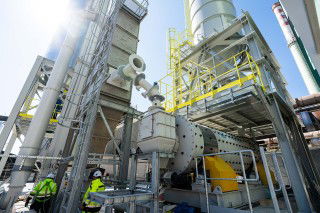This week, Vicem Hoang Mai Cement JSC, an affiliate of Vietnam Cement Industry Corporation (Vicem), was instructed by the provincial authorities to locate its prospective 4.5Mta Hong Mai 2 cement plant in a different location to the planned Hoang Mai 2 Industrial park site.
The decision will be a set-back for Vicem who had announced its intention to build the factory in October 2015 in the central province of Nghe An, as a two-phased project. Hoang Mai Cement is one of the older Vicem plants, in operation since July 2002, and has limestone reserves of approximately 125.6Mt.
Hoang Mai is not the first Vietnamese cement project to be forced to relocate, but in general the issue was confined to existing plants. In December last year, Ho Chi Minh City People’s Committee demanded that the Ha Tien 1 cement cease operations of its Th Duc grinding plant and look to relocate. Ho Chi Minh City has a population of some 8.4m and stricter environmental controls have been deemed necessary there by the authorities.
Furthermore, in June 2017 the Vietnam Ministry of Construction announced no new cement plants would be built in Ho Chi Minh City and existing plants would be relocated.
Vicem expansion and industry start-ups
Vietnam has an estimated 60 cement producers, of which 45 per cent have cement capacities below 1Mta and will feel the pressure to merge from larger corporations as these are keen to expand their operations. Vicem, the state-owned cement producer, has been a prime mover and currently runs nine cement production units, including the recent acquisitions of Ha Long, Song Da and Song Thao. The group has a leading market share of 35.75 per cent. While it has found growth via acquisition and merger relatively easy in a sector characterised by large overcapacity, winning environmental approval for new cement plants is proving more difficult in large cities where cement demand is highest.
New plant start-ups in Vietnam have included the Long Son Ltd Line 2 in Thanh Hoa, which started operation in September 2017, while Vissai Group-owned Song Lam Cement also launched its 3.8Mta greenfield plant in Nigh An in December 2016. Further capacity of 0.5Mta was added with the Can Thou-Hau Giang grinding station in 2016.
Meanwhile, Holcim Vietnam has had an approval for Thang Long Co Ltd to develop an inland port to develop the cement plant’s transport infrastructure.
Domestic market pick-up
The domestic market has started to improve in recent months with an estimated 45.28Mt of cement sold in the first nine months of 2017, while 13.99Mt of cement was exported.
The most difficult period for cement manufacturers has now passed, states Vietnam Net Bridge. While many cement producers have been forced into mergers and acquisitions to consolidate the industry, the recovery in the real estate market and lower interest rates are resulting in increased sales, along with incentives to export.
The largest driver for the domestic cement sector is in non-residential construction where US$2.05bn of value was created by the cement industry in 2016, according to analysts StoxPlus. City expansion is particularly evident in Hanoi and Ho Chi Minh.
Residential construction also offers substantial value to the cement sector. It was valued at US$2bn in 2016.
Infrastructure is similarly expected to offer strong growth for the cement sector with US$163bn of projects between 2015-25, according to StoxPlus.
Exports are still key
With cement and clinker exports reaching 17.6Mt in 2016, according to industry sources, Vietnam is still a significant player in southeast Asian seaboard trade. Vietnam’s Ministry of Planning and Investment proposed a reduction to the export tariff to help cement exporters in August, having seen clinker and cement export costs rise to US$4.50/t and US$7.50/t, respectively, putting Vietnamese cement exporters at a disadvantage to rivals from China, Thailand, Indonesia and Japan.

Turning waste concrete and CO2 into a binder
In July, Heidelberg Materials switched on the first continuous-mode enforced carbonation reactor...